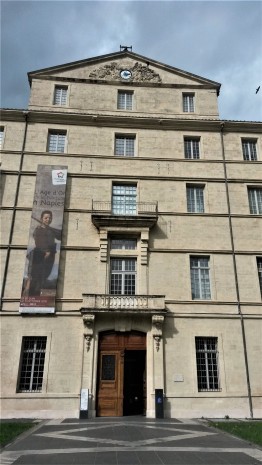
by Byron Beynon
Montpellier is where Paul Gaugin brought Vincent van Gogh in an attempt to cheer-up the fading spirits of the Dutchman. Late in 1888 both men travelled by train from Arles to spend the day in this southern French city, they came especially to see the works of Gustave Courbet and Eugene Delacroix inside the Musée Fabre. Vincent would soon write a letter to his brother Theo about the visit in the second half of December 1888.
“Gaugin and I went yesterday to Montpellier to see the museum there and especially the Brias room. There are a lot of portraits of Brias, by Delacroix, Ricard, Courbet, Cabanel, Couture, Verdier, Tassaert, and others. Then there are pictures by Delacroix, Courbet, Giotto, Paul Potter,
Botticelli, Th. Rousseau, very fine. Brias was a benefactor of artists, I shall say no more to you than that. In the portrait by Delacroix he is a gentleman with red beard and hair, confoundedly like you or me…..” In the same letter he goes on to say that “ Gaugin and I talked a lot about Delacroix, Rembrandt etc. Our arguments are terribly electric, we come out of them sometimes with our heads as exhausted as an electric battery after it has run down.”
Alfred Bruyas was indeed a benefactor of the arts and friend to artists, and his narcissism for having dozens of portraits of himself commissioned was defended by Vincent. After the trip, tensions grew between the two artists.

Today visitors still enter the gallery, which houses paintings, drawings, sculptures, video library, and a fine selection of books and magazines. The building is settled near a wide esplanade with plane trees and fountains, in the heart of the city. During the seventeenth century it was a Jesuit college, then a mansion before being enlarged when Francois Xavier Fabre (1766-1837), a former pupil of David, donated in 1825 his collection of paintings to his native city, and by doing so gave his name to this tall, wise building. Inside there are paintings by Rubens, Berthe Morisot, and Frédéric Bazille (1841-1870), who was born into an affluent Montpellier family of wine-growers, but who was tragically killed in the 1870 Franco-Prussian war. He began a career in medicine before turning to painting. He was, by all accounts, very well liked. He helped his impoverished artists friends, and in 1868 Bazille moved to a studio in Paris which he shared with Renoir.
Sadly he was killed during an attack on Beaune-la-Rolande. His father made the journey there to find the body of his son. For ten days he dug in the snow-covered battleground, eventually he found the body and hauled it back to Montpellier himself, on a peasant’s cart.

You can also see the portrait of CharlesBaudelaire painted in 1847 by Courbet, the poet with his black hair cut short, smokes a pipe, concentrating his mind on the pages of a book which rests on a table.
My first visit to France’s seventh largest city was in 1991, the following year I lived there for six months. I arrived by train, on the ultra-rapid TGV, to one of the country’s oldest protected stations,built in 1844. With a cosmopolitan population of over 270,000, a healthy mix of European youth, North African, American (there is an American library), many are students studying at the university, and the faculty of medicine, the oldest stillopen in the world. A papal bull, dated 26th of October 1289, announced the creation of the University of Montpellier, together with the medical, law, and arts faculties. Here the old, historical areas, with their narrow, shaded, antique streets exist in relative harmony with modern developments despite the angry graffiti and polluting traffic.
Since the 1960s which saw an increase in population, the council, led by Georges Freche decided to create a new neighbourhood called l’Antigone, a living area to provide accommodation and housing with relatively low rents for the people, it was the task of the Catalan architect, Ricardo Bofill, to extend this area of the city. Close by is the Polygone, a shopping centre with cafés, restaurants, and a plethora of shops.

One view of the city can be taken from the top of the Corum, a complex used for conventions and opera. To the north you can see the cathedral of St.Pierre, its twin, cylindrical towers stand like rockets about to be launched, also the orange-tiled roofs of the old quarter where on summer evenings, a young medical student named Felix Platter used to sit, playing his lute. He once wrote in his diary “I can see the town, spread out, as far as the sea, which I can sometimes hear in the wind”. If the Corum offered me a good view , the most popular meeting place for locals and visitors alike is the Place de la Comédie, with its fountain of the Three Graces. The three smiling girls embrace, gazing at people of all ages, passing by with their thoughts and with purpose.
Montpellier was first mentioned as far back as 985. By the year 1204 the crown of Aragon belonged to the city, eventually it was bought back by the French. It has witnessed the coming of Arab and Jewish scholars, a garrison, the French Revolution, the wine industry, a university, trams, underground parking and the new technology, pharmaceutical and research laboratories.
To get away from the centre I used to walk to the Peyrou with its eighteenth-century water tower, and the St.Clement aquaduct, the Arceaux, which brought water to the city. The cool air is reviving along with the panoramic views of the Mediterranean sea to the south and the mountains of the Pic Saint Loup to the north.
Nearby is the statue of Louis XIV, the Sun King, made of bronze it almost sank in Bordeaux harbour before arriving in Montpellier in 1718. There is also a botanical garden within easy walking distance from the Peyrou, created during the reign of Henry IV in 1593, with its exotic, ancient trees and plants. It is an oasis of green in the city. The poet Paul Valéry who had married the niece of the painter Berthe Morisot, enjoyed the peace here and wrote “we are going where you would go, if you were here, to the ancient garden where……all those people who meditate, worry or who talk to themselves go, as water goes to a river, and of course they meet up.”
In these gardens, one October afternoon, I met some students from the Netherlands. They were visiting Montpellier for a couple of weeks in order to improve their French, and were also doing a survey, asking questions about their homeland, the first question they asked me was to name at least one Dutch artist! “Vincent van Gogh “ I answered, “who came here by train with his friend and brother-in-art Paul Gaugin.”
Sources and books for further reading
The Letters of van Gogh edited by Mark Roskill (Fontana edition 1979)
The Private Lives of the Impressionists by Sue Roe (Chatto&Windus 2006)
Impressionism by Tamsin Pickeral (Flame Tree Publishing 2007)
.

Byron Beynon lives in Swansea, Wales. Collections include Cuffs (Rack Press) and The Echoing Coastline (Agenda Editions). His selected poems appeared in 2018 (Bilingual: English/Romanian – published by Bibliotecha Universalis/Collectiile/ Revistei “Orizont Literar Contemporan”, translations by Dr Monica Manolachi, University of Bucharest)
.
.